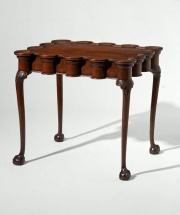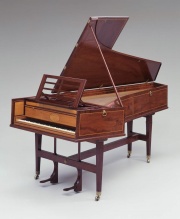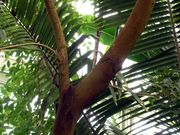Mahogany
Description
Tropical trees from the Miliaceae family (American genus Swietenia and African genus Khaya). Mahogany has a fine, straight grain that takes a high polish. It is dimensionally stable and does not shrink, warp, or swell. The durable, dark reddish-brown wood was imported to Europe in the 18th century where it became popular for furniture, paneling and veneer. Mahogany was used by Chippendale, Hepplewhite, and the Adam brothers for high quality furniture. Ammonia brings out a rich, red color in mahogany wood. Mahogany is frequently attacked by pinhole borer beetles.
Many woods of similar colors have also been called mahoganies, but usually do not have rich color or fine cutting characteristics of the true mahogany wood.
Related trees from the Miliaceae family are the Asian Ailanthus tree, the southeast Asian lauan tree and the Himalayan chinaberry tree.
Synonyms and Related Terms
West Indies Mahogany (Swietenia mahagoni) American mahogany or Honduras mahogany (Swietenia macrophylla); African mahogany (any Khaya species); caoba (Esp.); acajou (Fr.); Mahagoniholz (Deut); mogano (It.); acaju, mogno americano (Port.); mahogny (Sven.); acajou; jequitiba; madeira wood
Risks
Skin contact may cause allergic reactions.
Physical and Chemical Properties
- Medium tree growing to 20 m with short trunk and spreading crown.
- Leaves = Compound with 6-12 leaflets (5-15 cm long)
- Density = 35-48 ppcf
- Wood color is pinkish to reddish brown
- Grain is straight and consistent; texture is medium and uniform
Additional Images
Working Properties
- Excellent workability with easy sanding and machining
- Superb dimensional stability; minimal shrinkage or swelling with humidity
- Joint and glue-ups will remain intact
- Turns, glues, stains, and finishes well
Resources and Citations
- The Wood Database: Mahogany comparisons
- Alden Identification Services, Microscopic Wood Identification: Link
- Virginia Tech Dendrology website at www.fw.vt.edu/dendro/dendrology/main.htm (accessed Oct. 8, 2005)
- Wikipedia: Mahogany (Accessed Oct. 8, 2005 and October 2024)
- F. H. Titmuss, Commercial Timbers of the World, The Technical Press Ltd., London, 1965
- Dictionary of Building Preservation, Ward Bucher, ed., John Wiley & Sons, Inc., New York City, 1996
- R. J. Gettens, G.L. Stout, Painting Materials, A Short Encyclopaedia, Dover Publications, New York, 1966
- Ralph Mayer, A Dictionary of Art Terms and Techniques, Harper and Row Publishers, New York, 1969 (also 1945 printing)
- Hermann Kuhn, Conservation and Restoration of Works of Art and Antiquities, Butterworths, London, 1986
- Encyclopedia Britannica, http://www.britannica.com Comment: "mahogany" [Accessed October 24, 2001].
- G.S.Brady, Materials Handbook, McGraw-Hill Book Co., New York, 1971 Comment: p. 488
- Van Nostrand's Scientific Encyclopedia, Douglas M. Considine (ed.), Van Nostrand Reinhold, New York, 1976
- Random House, Webster's Encyclopedic Unabridged Dictionary of the English Language, Grammercy Book, New York, 1997
- The American Heritage Dictionary or Encarta, via Microsoft Bookshelf 98, Microsoft Corp., 1998
- Tom Rowland, Noel Riley, A-Z Guide to Cleaning, Conserving and Repairing Antiques, Constable and Co., Ltd., London, 1981
- Michael McCann, Artist Beware, Watson-Guptill Publications, New York City, 1979
- George Savage, Art and Antique Restorer's Handbook, Rockliff Publishing Corp, London, 1954







